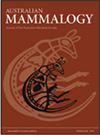New Guinean bandicoots: new insights into diet, dentition and digestive tract morphology and a dietary review of all extant non-Australian Peramelemorphia
IF 1.2
4区 生物学
Q3 ZOOLOGY
引用次数: 1
Abstract
Little is known about the diets and ecology of New Guinea’s 14 bandicoot species. In order to better understand the diet and digestive morphology of these marsupials, we reviewed the literature, studied the dental morphology, conducted analysis of gastrointestinal contents, and measured the digestive tracts of: Echymipera clara, E. davidi, E. kalubu, E. rufescens, Isoodon macrourus, Microperoryctes ornata, M. papuensis and Peroryctes raffrayana. These species consume a mix of fungi, insects and plant material that is broadly consistent with the omnivorous diet characteristic of most Australian bandicoots; however, morphological observations reveal variation between species that likely reflect finer-scale differences in diet. Dental morphology suggests a wider variety of diets (insectivore, omnivore, frugivore) than on the Australian mainland (mostly omnivore). Dissections and measurements of the digestive tract of seven New Guinean species indicate variation linked to diet. The relatively short caecum in all New Guinean species, but especially in E. clara and E. kalubu, is particularly suggestive of limited consumption of fibrous plant material; the relative length of the large intestine suggests variable capacity for water reabsorption. Our dietary data also suggest that some of these species also play an important role in the dispersal of hypogeous fungi.新几内亚土拨鼠:对饮食、牙齿和消化道形态的新认识,以及对所有现存非澳大利亚土拨鼠的饮食回顾
人们对新几内亚14种斑尾鹬的饮食和生态知之甚少。为了更好地了解这些有袋动物的饮食和消化形态,我们查阅了文献,研究了牙齿形态,进行了胃肠道内容物分析,并测量了以下动物的消化道:Echymipera clara、E.davidi、E.kalubu、E.rufescens、Isoodon macurus、Microperoryctes ornata、M.papuensis和Peroryctes raffrayana。这些物种食用真菌、昆虫和植物材料的混合物,这与大多数澳大利亚土匪的杂食性饮食特征大致一致;然而,形态学观察揭示了物种之间的差异,这可能反映了饮食的细微差异。牙齿形态表明,与澳大利亚大陆(主要是杂食动物)相比,饮食种类更丰富(食虫动物、杂食动物、食草动物)。对七种新几内亚物种消化道的解剖和测量表明,它们的变化与饮食有关。所有新几内亚物种的盲肠都相对较短,尤其是克拉氏E.clara和卡卢布E.kalubu,这特别表明纤维植物材料的消耗有限;大肠的相对长度表明水重吸收能力是可变的。我们的饮食数据还表明,其中一些物种在地下真菌的传播中也发挥着重要作用。
本文章由计算机程序翻译,如有差异,请以英文原文为准。
求助全文
约1分钟内获得全文
求助全文
来源期刊

Australian Mammalogy
ZOOLOGY-
CiteScore
2.50
自引率
8.30%
发文量
26
期刊介绍:
Australian Mammalogy is a major journal for the publication of research in all branches of mammalogy. The journal’s emphasis is on studies relating to Australasian mammals, both native and introduced, and includes marine mammals in the Antarctic region. Subject areas include, but are not limited to: anatomy, behaviour, developmental biology, ecology, evolution, genetics, molecular biology, parasites and diseases of mammals, physiology, reproductive biology, systematics and taxonomy.
Australian Mammalogy is for professional mammalogists, research scientists, resource managers, consulting ecologists, students and amateurs interested in any aspects of the biology and management of mammals.
Australian Mammalogy began publication in 1972 and is published on behalf of the Australian Mammal Society.
 求助内容:
求助内容: 应助结果提醒方式:
应助结果提醒方式:


